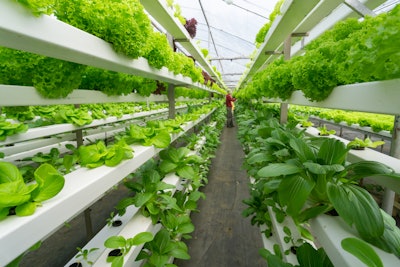
The American fresh produce supply chain is out of balance. Most crops can only thrive in a specific region or climate. For instance, Arizona and California account for nearly 90% of all leafy greens grown in America by weight while others rely heavily on overseas supplies of certain fruits and herbs to keep grocery shelves stocked.
The thousands-mile-long journeys that start in a California farm or Peruvian orchard are where the value is sucked out of the supply chain. Fresh produce often spends a majority of its edible lifespan on planes and trucks, crossing oceans and continents for weeks before reaching your local supermarket. Day by day, the nutritional value of this produce diminishes while food safety risks increase and the likelihood of that apple or basil plant becoming waste grows, rotten by the time it ends up at its destination.
Long journeys from field to fridge create challenges up and down the supply chain. Due to these inefficiencies, grocery stores typically have low profit margins on fresh produce. Supply fluctuation, further exacerbated by a changing climate and unpredictable growing conditions have left distributors seeking more reliable truckloads. And for consumers, access to consistent, fresh, and affordable produce is far from universal. The result? A lopsided and inefficient system that is overstraining distributors and deserting consumers.
Regionalized distribution can solve many of the issues facing fresh produce supply chains by lowering logistical costs, reducing food miles and waste, and ensuring peak freshness and affordability for consumers. By shrinking these journeys to minimize the time between harvest and consumption, we can create a more sustainable, resilient, and efficient food system that meets the demands of today's consumers.
How can we start to draw in this massive supply chain web? It is possible to drastically reduce food miles and minimize waste, but only if we consider each link in the supply chain: where and how the produce is grown, our means of distribution, and its ultimate destination.
First, regionalizing produce distribution requires diversity in where and how we grow crops. Technology will be the key in bringing agricultural production to more regions and closer to urban centers. Already today, new agricultural approaches are slowly entering the mainstream and making this transition possible. Controlled environment agriculture (CEA) systems like commercial greenhouses and vertical farms are bringing year-round supply with the flexibility to exist in any region of the country. Hydroponics, aquaponics, and precision agriculture are all emerging methods that can reshape the supply side of American agriculture. Local production also leads to job creation in areas beyond the traditional farming regions. These technologies will require continued investment and support from policymakers to reach their full potential, but are already bolstering supplies in select regions across the country.
With more widespread agricultural infrastructure comes an ability to effectively connect these technologies into regional distribution networks. An indoor farm in the Southeast should not see the majority of its shipments feeding consumers in the Upper Midwest. Instead, farms can distribute locally grown produce that prioritizes local consumers. By considering the goals of retailers and distribution centers, producers should have clear (and short) journeys in mind as much as possible for each shipment. This new framework can begin to shift standards and expectations for produce: shelf lives and ROI for fresh produce have immense room for growth and should be continually improved. While this framework is challenging in today’s supply chain, these evolutions in outcomes and perceptions around produce make it a compelling end goal for our industries to aspire to.
A broad approach to regional production and distribution ensures that produce reaches consumers at peak freshness while uncovering savings and cutting down on the environmental impact associated with long-distance transportation. Regionalized distribution can also create a big impact on a human level. By reducing reliance on centralized facilities and long-haul trucking, fresh, sustainable produce can reach underserved communities with greater ease and less waste.
Produce is a fragile yet vital category where efficiency directly determines the quality, cost and nutritional value of the product on the shelf. Today’s supply chains should reflect these particular needs and challenges to best serve distributors, retailers, and consumers alike. Fresh produce should never have to feel like a faraway, luxury item for families. Nobody should have to live in a produce desert due to logistical shortcomings.
Investing in regional solutions through new forms of technology and streamlined distribution is all about access, but also, awareness. A fresher, more reliable supply can and should alter customer expectations around what goods are affordable and readily available for them and their communities. Expanding access is no small feat, but by considering each step from farm to shelf to simplify a crop’s journey, we can begin to envision, build, and maintain a more sustainable and equitable food system for all.



















